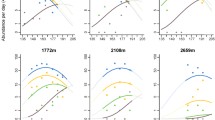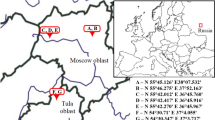Abstract
Alpine and subalpine moorland ecosystems contain unique plant communities, often with many endemic and threatened species, some of which depend on insect pollination. Although alpine and subalpine moorland ecosystems are vulnerable to climatic change, few studies have investigated flower-visiting insects in such ecosystems and examined the factors regulating plant-pollinator interactions along altitudinal gradients. Here, we explored how altitudinal patterns in flower visitors change according to altitudinal shifts in flowering phenology in subalpine moorland ecosystems in northern Japan. We surveyed flower-visiting insects and flowering plants at five sites differing in altitude in early July (soon after snowmelt) and mid-August (peak growing season). In July, we found a higher visiting frequency by more variable insect orders including dipteran, hymenopteran, coleopteran, and lepidopteran species at the higher altitude sites in association with the mass flowering of Geum pentapetalum and Nephrophyllidium crista-galli. In August, such altitudinal patterns were not observed, and dipteran species dominated across the sites due to the flowering of Narthecium asiaticum and Drosera rotundifolia. Our study provides key baselines for the detection of endangered biotic interactions and extinction risks of moorland plants under ongoing climate change.



Similar content being viewed by others
Data availability
The data are available from the corresponding author upon reasonable request.
References
Bascompte J, Jordano P, Melián CJ, Olesen JM (2003) The nested assembly of plant-animal mutualistic networks. Proc Natl Acad Sci USA 100:9383–9387. https://doi.org/10.1073/pnas.1633576100
Beniston M (2006) Mountain weather and climate: A general overview and a focus on climatic change in the Alps. Hydrobiologia 562:3–16. https://doi.org/10.1007/s10750-005-1802-0
Blionis GJ, Halley JM, Vokou D (2001) Flowering phenology of Campanula on Mt Olympos, Greece. Ecography 24:696–706. https://doi.org/10.1111/j.1600-0587.2001.tb00531.x
Branquart E, Hemptinne J-L (2000) Selectivity in the exploitation of floral resources by hoverflies (Diptera: Syrphinae). Ecography 23:732–742. https://doi.org/10.1111/j.1600-0587.2000.tb00316.x
Campbell DR, Bischoff M, Lord JM, Robertson AW (2010) Flower color influences insect visitation in alpine New Zealand. Ecology 91:2638–2649. https://doi.org/10.1890/09-0941.1
Chapin FS, Mcguire AD, Randerson J et al (2000) Arctic and boreal ecosystems of western North America as components of the climate system. Glob Chang Biol 6:211–223. https://doi.org/10.1046/j.1365-2486.2000.06022.x
Chatelain P, Plant A, Soulier-Perkins A, Daugeron C (2018) Diversity increases with elevation: empidine dance flies (Diptera, Empididae) challenge a predominant pattern. Biotropica 50:633–640. https://doi.org/10.1111/btp.12548
Classen A, Eardley CD, Hemp A et al (2020) Specialization of plant–pollinator interactions increases with temperature at Mt. Kilimanjaro. Ecol Evol 10:2182–2195. https://doi.org/10.1002/ece3.6056
Cornelius C, Estrella N, Franz H, Menzel A (2013) Linking altitudinal gradients and temperature responses of plant phenology in the Bavarian Alps. Plant Biol 15:57–69. https://doi.org/10.1111/j.1438-8677.2012.00577.x
Galeuchet DJ, Perret C, Fischer M (2005) Performance of Lychnis flos-cuculi from fragmented populations under experimental biotic interactions. Ecology 86:1002–1011. https://doi.org/10.1890/03-0762
Hájková P, Hájek M, Apostolova I (2006) Diversity of wetland vegetation in the Bulgarian high mountains, main gradients and context-dependence of the pH role. Plant Ecol 184:111–130. https://doi.org/10.1007/s11258-005-9056-5
Heck KL, van Belle G, Simberloff D (1975) Explicit calculation of the rarefaction diversity measurement and the determination of sufficient sample size. Ecology 56:1459–1461
Hegland SJ, Boeke L (2006) Relationships between the density and diversity of floral resources and flower visitor activity in a temperate grassland community. Ecol Entomol 31:532–538. https://doi.org/10.1111/j.1365-2311.2006.00812.x
Hines HM, Hendrix SD (2009) Bumble bee (Hymenoptera: Apidae) diversity and abundance in tallgrass prairie patches: Effects of local and landscape floral resources. Environ Entomol 34:1477–1484. https://doi.org/10.1603/0046-225x-34.6.1477
Kudo G, Kawai Y, Amagai Y, Winkler DE (2017) Degradation and recovery of an alpine plant community: experimental removal of an encroaching dwarf bamboo. Alp Bot 127:75–83. https://doi.org/10.1007/s00035-016-0178-2
Lefebvre V, Villemant C, Fontaine C, Daugeron C (2018) Altitudinal, temporal and trophic partitioning of flower-visitors in Alpine communities. Sci Rep 8:1–12. https://doi.org/10.1038/s41598-018-23210-y
Makishima D, Sutou R, Goto A et al (2021) Potential extinction debt due to habitat loss and fragmentation in subalpine moorland ecosystems. Plant Ecol 222:445–457. https://doi.org/10.1007/s11258-021-01118-4
Mizunaga Y, Kudo G (2017) A linkage between flowering phenology and fruit-set success of alpine plant communities with reference to the seasonality and pollination effectiveness of bees and flies. Oecologia 185:453–464. https://doi.org/10.1007/s00442-017-3946-9
Muraoka H, Takakura S (1988) Explanatory text of the geological map of the Hakkoda Geothermal area. Miscellaneous Map Series (No. 21–4), Geological Survey of Japan, Tsukuba, p 27 [in Japanese]
Ollerton J, Winfree R, Tarrant S (2011) How many flowering plants are pollinated by animals? Oikos 120:321–326. https://doi.org/10.1111/j.1600-0706.2010.18644.x
Pollard E, Yates TJ (1993) Monitoring Butterflies for Ecology and Conservation. Chapman & Hall, London
R Development Core Team (2020) R: A language and environment for statistical computing (ver. 4.0.3). R Foundation for Statistical Computing, Vienna
Ramsar Convention Bureau (2002) What Is the Ramsar Convention on Wetlands? Ramsar Information Paper no. 2. Ramsar Convention Bureau, Gland. https://www.ramsar.org/sites/default/files/documents/library/info2007-02-e.pdf. Accessed 8 Jan 2020
Sasaki T, Katabuchi M, Kamiyama C et al (2013) Variations in species composition of moorland plant communities along environmental gradients within a subalpine zone in northern japan. Wetlands 33:269–277. https://doi.org/10.1007/s13157-013-0380-6
Sasaki T, Katabuchi M, Kamiyama C et al (2014) Vulnerability of moorland plant communities to environmental change: Consequences of realistic species loss on functional diversity. J Appl Ecol 51:299–308. https://doi.org/10.1111/1365-2664.12192
Scriven LA, Sweet MJ, Port GR (2013) Flower density is more important than habitat type for increasing flower visiting insect diversity. Int J Ecol 2013:237457. https://doi.org/10.1155/2013/237457
Tomitaka M, Uchihara S, Goto A, Sasaki T (2021) Species richness and flower color diversity determine aesthetic preferences of natural-park and urban-park visitors for plant communities. Environ Sustain Indic 11:100130. https://doi.org/10.1016/j.indic.2021.100130
Zhao Y, Lázaro A, Li H et al (2022) Morphological trait-matching in plant–Hymenoptera and plant–Diptera mutualisms across an elevational gradient. J Anim Ecol 91:196–209. https://doi.org/10.1111/1365-2656.13614
Zoller H, Lenzin H, Erhardt A (2002) Pollination and breeding system of Eritrichium nanum (Boraginaceae). Plant Syst Evol 233:1–14. https://doi.org/10.1007/s006060200052
Acknowledgements
We thank our laboratory members for helping with the fieldwork, especially Daichi Makishima, Shoko Uchihara, and Mahoro Tomitaka. We also thank Taiki Tachibana and Yuki Iwachido for their valuable suggestions for data analysis.
Funding
This work was financially supported by a Fostering Joint International Research A award (no. 19KK0393) and a Grant-in-Aid for Scientific Research B (No.18H02221 and No. 20H04380) from the Japanese Ministry of Education, Culture, Sports, Science and Technology.
Author information
Authors and Affiliations
Contributions
NM: conceptualization, investigation, analyses, and writing. AG: investigation and editing. KU: investigation and editing. TS: conceptualization, investigation, editing, and resources. NM, AG, KU and TS approved the final version of manuscript.
Corresponding author
Ethics declarations
Competing interest
None.
Additional information
Publisher's note
Springer Nature remains neutral with regard to jurisdictional claims in published maps and institutional affiliations.
Rights and permissions
Springer Nature or its licensor (e.g. a society or other partner) holds exclusive rights to this article under a publishing agreement with the author(s) or other rightsholder(s); author self-archiving of the accepted manuscript version of this article is solely governed by the terms of such publishing agreement and applicable law.
About this article
Cite this article
Matsubara, N., Goto, A., Uchida, K. et al. Patterns of flower-visiting insects depend on flowering phenological shifts along an altitudinal gradient in subalpine moorland ecosystems. Biologia 78, 809–818 (2023). https://doi.org/10.1007/s11756-022-01284-4
Received:
Accepted:
Published:
Issue Date:
DOI: https://doi.org/10.1007/s11756-022-01284-4




